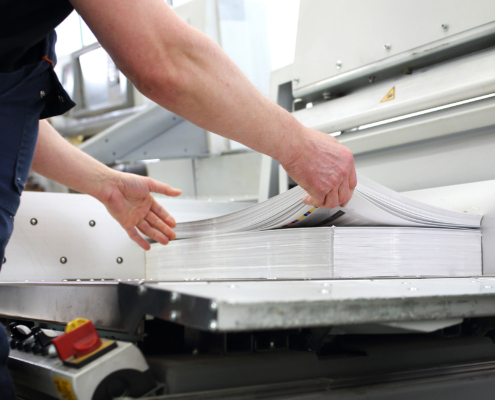 https://sosny.com/wp-content/uploads/2025/12/printing-in-office.jpg
1250
2000
Abstrakt Marketing
/wp-content/uploads/2025/11/SOS-Logo-Color-New.png
Abstrakt Marketing2025-12-05 16:14:392026-01-06 20:27:29Printing Industry Trends in 2025: How Tariffs Are Reshaping Office Technology
https://sosny.com/wp-content/uploads/2025/12/printing-in-office.jpg
1250
2000
Abstrakt Marketing
/wp-content/uploads/2025/11/SOS-Logo-Color-New.png
Abstrakt Marketing2025-12-05 16:14:392026-01-06 20:27:29Printing Industry Trends in 2025: How Tariffs Are Reshaping Office Technology7 Ways to Improve Your Digital Print Workflow With Automation
Digital print automation has become a game-changer for businesses seeking efficient, high-quality output at scale. Streamlined workflows can help reduce errors, speed up production times, and optimize resource use. By taking a methodical approach to refining your print workflow with automation, you’ll be better prepared to meet evolving demands and stay ahead of the competition.
Understanding the Role of Automation in Print Workflows
Automation plays a pivotal role in modern digital print workflows by eliminating manual intervention in repetitive tasks, which reduces error rates and accelerates production. It involves creating a seamless connection between software, hardware, and human processes so that each step—such as job submission, file processing, and finishing—occurs smoothly with minimal oversight.
An efficient automated workflow boosts productivity and enhances quality control by making monitoring and tracking each job easier. Businesses that upgrade their print workflows with automation are better equipped to handle high-volume orders, tailor jobs to specific customer needs, and adapt quickly when changes in demand or technology arise.
7 Ways to Enhance Your Print Workflow With Automation
Improving your digital print automation isn’t just about investing in the latest equipment, but identifying where manual processes slow you down and strategically implementing solutions to address them. Below are several approaches that can help you enhance your print workflow through automation and ensure your team operates at peak efficiency.
1. Identify Weak Points in Your Print Workflow
Start by mapping out your existing workflow in detail—from job intake to final delivery—and look for areas where errors frequently occur or where bottlenecks develop. This exercise may reveal inefficient processes, outdated equipment, or communication gaps that hinder your production. Once you have a clear overview, determine which steps would benefit most from automation, whether it’s eliminating repetitive tasks or centralizing control of print queues.
By identifying these weak points, you can focus your energy on updates and improvements that yield the highest impact, making your entire operation more responsive and streamlined.
2. Consult With Customers
While internal efficiency is crucial, aligning upgrades with customer expectations is equally important. Through direct conversations or surveys, discover what factors matter most to your clients—speed, print quality, consistency, or customization options—and verify that your automation improvements address those priorities. Automating certain processes might mean faster turnaround times, but only if the new systems align with the types of orders your customers typically place.
Bringing clients into the conversation early allows you to create an environment where continuous feedback informs each stage of your automation rollout, ensuring the final workflow delivers real value to both parties.
3. Reduce Physical Touch-Points
Excessive manual interventions can lead to delays, errors, and communication breakdowns in your print workflow. To combat this, implement automation tools that minimize physical handoffs, whether it’s shifting job submissions to a digital platform or using automated finishing equipment. Real-time monitoring solutions offer visibility into each stage of production, allowing you to spot issues before they escalate.
Reducing physical touch-points and using integrated tracking software grants better control over job progression. This minimizes downtime and boosts accountability, as every task becomes associated with specific quality checks and measurable performance metrics.
4. Integrate Print Workflow Software
One key advantage of modern print automation is adapting quickly as your business grows or pivots. Consider investing in workflow management software capable of scaling or integrating with new tools over time. For instance, you could begin by automating job scheduling and then add quality control modules or advanced analytics features as your production demands increase. Modular or cloud-based software solutions can often be updated with new functionalities, helping you stay ahead of industry trends.
This approach ensures your print workflow remains future-proof, preventing the need for disruptive overhauls each time your organization evolves.
5. Evaluate Your Digital Press Operation Needs
Not all areas of your operation will require the same level of automation—some might benefit from advanced finishing equipment, while others could see gains from software-based solutions. Conduct a thorough audit of your digital press capabilities and compare them against the array of technological options on the market. This could include everything from auto-duplexing and inline binding to AI-driven color calibration.
By matching your needs with available technologies, you create an optimized workflow that prioritizes the most critical pain points without investing in features that offer minimal returns for your specific production environment.
6. Leverage the Technical Expertise of Your Organization
Your team’s insights can be invaluable in improving digital print automation. Involve employees from various roles—machine operators, IT specialists, customer service reps—in discussions about where automation could have the greatest effect. These frontline personnel often have direct knowledge of recurring issues or customer complaints, enabling a targeted approach to upgrading processes and systems. Encourage open communication and continuous learning through training programs and workshops.
Tapping into your internal talent pool lets you create a collaborative culture that thrives on innovation. This ensures that your automation strategies are practical and fully supported by those who execute them daily.
7. Strengthen Data Security and Compliance Protocols
When introducing new digital solutions into your printing process, it’s essential to consider data security and compliance. Automated workflows often involve the transfer of sensitive customer information, necessitating robust protections at each stage of production. Encrypt data flows, limit access through role-based permissions, and maintain detailed logs for auditing purposes. Stay updated on industry-specific regulations that may influence how you handle and store customer files.
Integrating strong security measures into your automation strategy mitigates risks, builds trust with your clients, and safeguards the valuable intellectual property handled within your printing environment.
Uncover the main reasons you should implement print workflow automation into your business operations and how it can streamline the job submission process.
Improve Your Print Workflow Automation With Superior Office Solutions
Elevating your digital print workflow with automation is a multifaceted endeavor that requires careful planning, ongoing assessment, and the right blend of technology and expertise. Superior Office Solutions understands the complexities of modern print environments and offers tailored guidance to help businesses streamline workflows, reduce costs, and enhance output quality.
By partnering with us, you can create an adaptable, future-focused print operation that stays competitive in an ever-evolving marketplace. Contact Superior Office Solutions today to learn how our custom solutions and dedicated support can transform your print operations and drive sustainable growth.
Share This Post
More Like This
 https://sosny.com/wp-content/uploads/2025/12/printing-in-office.jpg
1250
2000
Abstrakt Marketing
/wp-content/uploads/2025/11/SOS-Logo-Color-New.png
Abstrakt Marketing2025-12-05 16:14:392026-01-06 20:27:29Printing Industry Trends in 2025: How Tariffs Are Reshaping Office Technology
https://sosny.com/wp-content/uploads/2025/12/printing-in-office.jpg
1250
2000
Abstrakt Marketing
/wp-content/uploads/2025/11/SOS-Logo-Color-New.png
Abstrakt Marketing2025-12-05 16:14:392026-01-06 20:27:29Printing Industry Trends in 2025: How Tariffs Are Reshaping Office Technology https://sosny.com/wp-content/uploads/2025/11/Desktop-vs.-Standalone-Office-Machines_-Which-Is-Right-for-Your-Business_.jpg
1250
2000
Abstrakt Marketing
/wp-content/uploads/2025/11/SOS-Logo-Color-New.png
Abstrakt Marketing2025-11-13 21:52:152026-01-06 20:27:30Desktop vs. Standalone Office Machines: Which Is Right for Your Business?
https://sosny.com/wp-content/uploads/2025/11/Desktop-vs.-Standalone-Office-Machines_-Which-Is-Right-for-Your-Business_.jpg
1250
2000
Abstrakt Marketing
/wp-content/uploads/2025/11/SOS-Logo-Color-New.png
Abstrakt Marketing2025-11-13 21:52:152026-01-06 20:27:30Desktop vs. Standalone Office Machines: Which Is Right for Your Business? https://sosny.com/wp-content/uploads/2025/11/VoIP-vs.-Unified-Communications.jpg
1250
2000
Abstrakt Marketing
/wp-content/uploads/2025/11/SOS-Logo-Color-New.png
Abstrakt Marketing2025-11-13 21:43:342026-01-06 20:27:30VoIP vs. Unified Communications
https://sosny.com/wp-content/uploads/2025/11/VoIP-vs.-Unified-Communications.jpg
1250
2000
Abstrakt Marketing
/wp-content/uploads/2025/11/SOS-Logo-Color-New.png
Abstrakt Marketing2025-11-13 21:43:342026-01-06 20:27:30VoIP vs. Unified Communications https://sosny.com/wp-content/uploads/2025/10/office-workers-at-printer.jpg
1250
2000
Abstrakt Marketing
/wp-content/uploads/2025/11/SOS-Logo-Color-New.png
Abstrakt Marketing2025-10-30 13:27:142026-01-06 20:27:30Top 5 Reasons Kyocera Printers Are a Smart Choice for Small Businesses
https://sosny.com/wp-content/uploads/2025/10/office-workers-at-printer.jpg
1250
2000
Abstrakt Marketing
/wp-content/uploads/2025/11/SOS-Logo-Color-New.png
Abstrakt Marketing2025-10-30 13:27:142026-01-06 20:27:30Top 5 Reasons Kyocera Printers Are a Smart Choice for Small Businesses https://sosny.com/wp-content/uploads/2025/10/Person-in-law-firm-looking-at-paperwork.jpg
1250
2000
Abstrakt Marketing
/wp-content/uploads/2025/11/SOS-Logo-Color-New.png
Abstrakt Marketing2025-10-28 17:09:082026-01-06 20:27:31Industry Spotlight: Law Firm Printing and Data Security Needs
https://sosny.com/wp-content/uploads/2025/10/Person-in-law-firm-looking-at-paperwork.jpg
1250
2000
Abstrakt Marketing
/wp-content/uploads/2025/11/SOS-Logo-Color-New.png
Abstrakt Marketing2025-10-28 17:09:082026-01-06 20:27:31Industry Spotlight: Law Firm Printing and Data Security Needs https://sosny.com/wp-content/uploads/2025/10/Worker-repair-printer.jpg
1250
2000
Abstrakt Marketing
/wp-content/uploads/2025/11/SOS-Logo-Color-New.png
Abstrakt Marketing2025-10-13 20:49:442026-01-06 20:27:31The Hidden Costs of DIY Printer Repairs—And When to Call a Pro
https://sosny.com/wp-content/uploads/2025/10/Worker-repair-printer.jpg
1250
2000
Abstrakt Marketing
/wp-content/uploads/2025/11/SOS-Logo-Color-New.png
Abstrakt Marketing2025-10-13 20:49:442026-01-06 20:27:31The Hidden Costs of DIY Printer Repairs—And When to Call a Pro https://sosny.com/wp-content/uploads/2025/09/Is-a-Production-Printer-Right-for-Your-Business.jpg
1250
2000
Abstrakt Marketing
/wp-content/uploads/2025/11/SOS-Logo-Color-New.png
Abstrakt Marketing2025-09-08 12:51:232026-01-06 20:27:31Is a Production Printer Right for Your Business?
https://sosny.com/wp-content/uploads/2025/09/Is-a-Production-Printer-Right-for-Your-Business.jpg
1250
2000
Abstrakt Marketing
/wp-content/uploads/2025/11/SOS-Logo-Color-New.png
Abstrakt Marketing2025-09-08 12:51:232026-01-06 20:27:31Is a Production Printer Right for Your Business? https://sosny.com/wp-content/uploads/2025/09/What-to-Include-in-Your-Printer-Security-Checklist.jpg
1250
2000
Abstrakt Marketing
/wp-content/uploads/2025/11/SOS-Logo-Color-New.png
Abstrakt Marketing2025-09-08 12:43:322026-01-06 20:27:32Printer Security Checklist
https://sosny.com/wp-content/uploads/2025/09/What-to-Include-in-Your-Printer-Security-Checklist.jpg
1250
2000
Abstrakt Marketing
/wp-content/uploads/2025/11/SOS-Logo-Color-New.png
Abstrakt Marketing2025-09-08 12:43:322026-01-06 20:27:32Printer Security Checklist https://sosny.com/wp-content/uploads/2025/09/The-Hidden-Threat-in-Your-Office.jpg
1250
2000
Abstrakt Marketing
/wp-content/uploads/2025/11/SOS-Logo-Color-New.png
Abstrakt Marketing2025-09-08 12:34:102026-01-06 20:27:32The Importance of Copier Security: How Your Office Equipment Might Be Storing Sensitive Data
https://sosny.com/wp-content/uploads/2025/09/The-Hidden-Threat-in-Your-Office.jpg
1250
2000
Abstrakt Marketing
/wp-content/uploads/2025/11/SOS-Logo-Color-New.png
Abstrakt Marketing2025-09-08 12:34:102026-01-06 20:27:32The Importance of Copier Security: How Your Office Equipment Might Be Storing Sensitive Data


